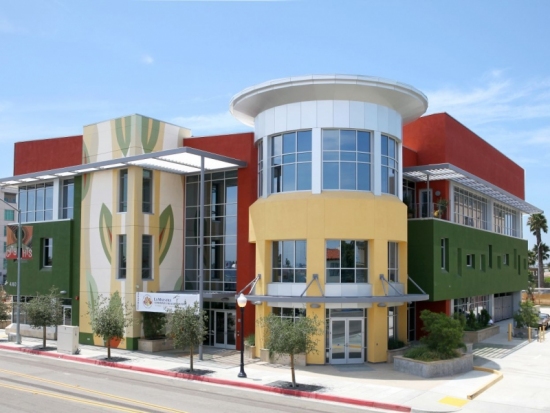A related term is operational readiness: an organization is operationally ready to provide care and services if it has the right people at the right place at the right time, working with the right equipment and technology in accordance with the right policies and protocols.
Construction
Construction
Print/View All
What is Construction?
There are several approaches to constructing a building. Using a design-build or construction management approach means the contractor will already be well-versed in your project. In a traditional design-bid-build process, the project is put out to bid, and a general contractor is selected according to pre-established factors, such as experience, schedule, and cost.
During the construction phase, the goal of the project team is to monitor the implementation of the design into construction to ensure that the original intent has not been compromised. Activities occurring during construction that are led by the healthcare organization include: launching internal readiness and process improvement plans, obtaining zoning and use permits, establishing early permit and third party approvals, and beginning transition planning, and obtaining the Certificate of Occupancy (CO).
Construction Activities
Activities developed during this phase that are design team-led processes include: coordinating construction administration documents, developing punch lists, and completing project close-out.
Evidence-Based Design
The team should monitor implementation of design (Step Seven) to ensure EBD innovations are implemented as envisioned during the design phase.
Design Activities
The purpose of the manual is to maintain all key information related to the project in a single location, so that once the development team has been disbanded, the clinic staff has the information necessary to manage the building.
Effective management of the project includes maintenance of project correspondence, conducting progress meeting, handling submittals and requests for information, documentation of progress, review of pay requests, schedule reviews and schedule updates.
This involves negotiation of change orders with the contractor, coordination with the designer over design changes, determination of responsibility for changed conditions or coordination conflict, and review of price and schedule changes.
Review the project to ensure orderly and timely completion, including development of punchlists; monitoring of implementation, training and warranty periods; resolution of outstanding issues; review and analysis of claims or disputed issues.
The CM and/or architect usually examines project performance on a continuous or periodic basis to review progress, ensure compliance with specifications and plans, to review housekeeping and safety issues.
When the project is nearing completion, the architect will conduct a walk-through with the contractor, project manager and clinic representative, creating what is known as the “punch-list,” unfinished tasks that are listed as conditions to be completed by the contractor prior to final payment.
Substantial completion is evaluated by the architect and is where the Owner assumes responsibility for the building. It is set from the beginning of construction, and is significant as it is a transfer point of risk and liability from the Contractor to the Owner. It is the beginning of project closeout, but work is still required, such as punch list items.
Part of a state's mechanics' lien law system. Signed by the owner, it is legally recorded with the proper authority within 10 days after completion of construction.
This is after the punch list work is complete, and after the owner, the builder, the architect, and often the lender make a final inspection of the site. When the final inspection is successfully completed, the architect issues a certificate for final payment, allowing the builder to collect payments still due.
Establish the activation and move plan to determine the specific of how the new facility or renovation will be operational on Day One with considerations such a staff moves, equipment moves, use of temporary space, and technology testing.
Commissioning ensures that upon occupancy, the new building systems (HVAC, lighting, water) operate as intended and that building staff are prepared to operate and maintain its systems and equipment. Enhanced commissioning can include additional items.
Project closeout is initiated when the contractor notifies the Owner, that the building is sufficiently completed (according to the Certificate of Substantial Completion) and is ready for occupancy. The closeout includes resolution of change orders and the final payment, completion of punch-list items, training and maintenance manuals/warranties for building systems, and the creation of lien waivers.
Evidence-Based Design Activities
FAQs
There are two types of Construction Managers (CMs). Through an agency CM, construction cost management is a fee-based service in which CM is responsible exclusively to the owner and acts in the owner's interests at every stage of the project. The construction manager offers advice on matters such as:
- Optimum use of available funds;
- Control of the scope of the work;
- Project scheduling;
- Optimum use of design and construction firms' skills and talents;
- Avoidance of delays, changes and disputes;
- Enhancing project design and construction quality;
- Optimum flexibility in contracting and procurement;
- Cash flow Management.
An Agency CM provides management of every stage of the project, beginning with the original concept and project definition and can represent the owner by helping to select the design team as well as the construction team and manage the design preventing scope creep, helping the owner stay within a pre-determined budget by performing Value Engineering, Cost/Benefit Analysis and Best Value Comparisons.
A second type of CM is a CM at-risk. This is a delivery method which entails a commitment by the construction manager to deliver the project within a Guaranteed Maximum Price (GMP. The construction manager acts as consultant to the owner in the development and design phases, (often referred to as "Preconstruction Services"), but as the equivalent of a general contractor during the construction phase. When a construction manager is bound to a GMP, the most fundamental character of the relationship is changed. In addition to acting in the owner's interest, the construction manager must manage and control construction costs to not exceed the GMP. (Source: adapted from http://en.wikipedia.org/wiki/Construction_management)
Operational readiness includes:
- Redesigned models of patient care and workflow
- Human resources strategy including physician strategy
- IT/IS and telecom strategy and implementation
- Opening day definition and ramp down and up plans
- Financial plans and operating budget
- Stakeholder relations and meeting expectations
- Internal and external communications
- Orientation and training
Related activities include a change readiness assessment that can be conducted to understand barriers to change. This includes which stakeholder groups are most resistant to change, their specific concerns, and how those concerns can be addressed. It also provides a quantitative measure to monitor readiness and alignment over time
Resources
Created by the Construction Management Association of America (CMAA). The phases and activities related to this resource include:
Construction
- Conduct construction inspection and surveillance
- Substantial completion
- Notice of completion
- Final completion
Authored by Sydney M. Levy. Phases and activities related to this resource include:
Construction
- Conduct construction inspection and surveillance
- Substaintial completion
- Notice of completion
- Final completion
Created by NCB Capital Impact. Phases and activities related to this resource include:
Organizational Readiness
- Conduct operational planning
- Conduct allocation planning/preliminary space assessment
- Finalize strategic planning
- Develop community awareness/engagement
- Develop the business plan (Sect VII)
- Development of project budget
- Explore various financing options
- Develop a preliminary project schedule
- Hire a project manager and architect (Sect IV)
Pre-Design
- Determine financial feasability
- Conduct a market needs analysis and assessment
- Select/survey sites and evaluate space availability (Sect IV.b)
- Select an attorney, architect/interior designer, contractor and construction manager
- Establish the remaining project team
- Property aquisition/site control
- Refine project budget/schedule (Sect VIII)
Design
- Continue conceptual diagramming
- Design development
- Permit process
- Zoning/use processing
- Furniture, fixtures, equipment (FFE) and technology planning
- Purchasing plan
- Construction documents
- Value engineering (p. 33)
- Early permit - third party approvals (p. 40-41)
- Bid and award - this may be phased, based on contract type
Construction
- Conduct construction inspection and surveillance (p. 43-49)
- Create the punch list (p. 55)
Created by Clinica Sierra Vista. Phases and activites related to this resource include:
Construction
- Transition planning
- Project close out
Occupancy
- Marketing/Outreach planning
Created by Construction Management Association of America (CMAA). Phases and activities related to this resource include:
Pre-Design
- Select an attorney, architect/interior designer, contractor and construction manager
Design
Construction
- Establish project controls
- Substantial completion
- Notice of completion
- Final completion
.
Study Guide 3: Integrating Evidence-Based Design: Practicing the Healthcare Design Process.
Guide Three pulls together the evidence-based design (EBD) process to walk you through the key steps of the design process in detail from pre-design, design, construction and occupancy. Practical examples demonstrate key areas and show how EBD is practically applied.
Phases and activities related to this resource include:
Organizational Readiness
Pre-Design
- Evaluate work flow
- Start conceptual diagramming
Design
- Continue conceptual diagramming
- Design development
- Bid and award-this may be phased based on contract type
Construction
- Substantial completion
- Final completion
Occupancy
Created by Labs for the 21st Century/EPA/DoE and covers the entire design process with a focus on sustainability. Phases and activities associated with this resource include:
Construction
- Commissioning phase
Created by Deloitte. Phases and activities included in this phase include:
Organizational Readiness
- Conduct operational planning
- Determine staffing needs
- Develop a business plan
- Plan for the project mission/vision
Construction
- Internal readiness
Created by New York State Division of Housing and Community Renewal (DHCR)/Franke Consulting Group.
Created by the Facility Guidelines Institute, 2010 edition. There is a read only version of the guidelines at the bottom of the linked page. Phases and Activities applicable to this resource include:
Pre-Design
- Select/survey sites and evaluate space availability
- Property aquisition/site control
- Start conceptual diagraming
Design
- Continue conceptual diagraming
- Schematic design
- Design development
- Permit process
- Zoning/use processing
- Construction documents
Construction
- Notice of completion
- Final completion
- Commissiong phase
Occupancy
- Certificate of occupancy
- Licensing
A free resource from Capital Link and Primary Care Development Corporation on developing a health center. Phases and Activities applicable to this resource include:
Organizational Readines
- Conduct operational planning
- Conduct allocation planning/preliminary space assessment
- Finalize strategic planning
- Create project organizational leadership
- Development of project budget
- Explore various financing options
- Consider sites (see chapter 5)
- Develop a preliminary project schedule (see chapter 2, and Appendix B)
- Hire a project manager and architect
Pre-Design
- Determine financial feasability
- Select/survey sites and evaluate space availability (see chapter 5)
- Select an attorney, architect/interior designer, contractor and construction manager (see chapter 3-4, 6 and Appendix D)
- Establish the remaining project team (see chapter 4, Appedix D and E)
- Property aquisition/site control
- Plan and program
- Refine project budget/schedule
- Start conceptual diagraming
Design
- Continue conceptual diagraming
- Schematic design
- Design development
- Construction documents
- Bid and award - this may be phased based on project type (see chapter 7)
Construction
- Notice of completion
- Final completion
- Transition planning
Clinic Examples
With 16 health centers and 54 different locations, Clinica Sierra Vista provides health care services to a large, underserved Hispanic population spread over 6,000 square miles. According to Doug...
Unique feature: The Clinica de la Raza Community Health Center is a component of a transit-based development village that provides physical renewal and economic...
